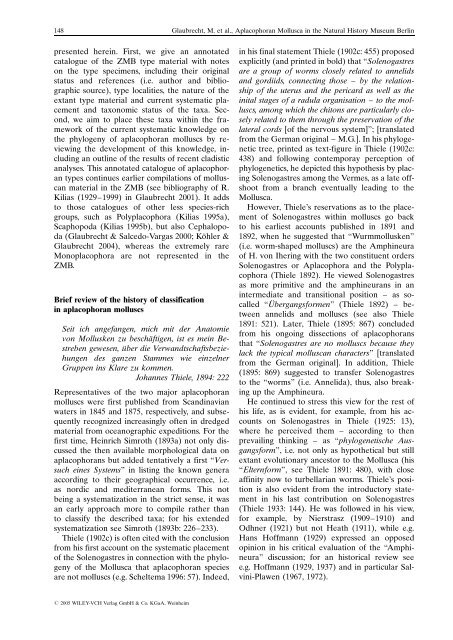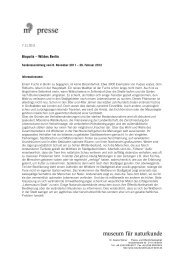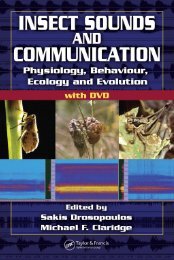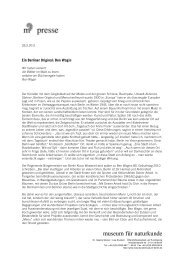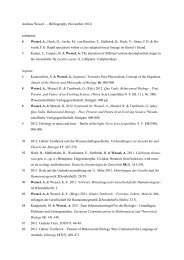Glaubrecht et al 2005.pdf - Download.naturkundemuseum-berlin.de ...
Glaubrecht et al 2005.pdf - Download.naturkundemuseum-berlin.de ...
Glaubrecht et al 2005.pdf - Download.naturkundemuseum-berlin.de ...
Create successful ePaper yourself
Turn your PDF publications into a flip-book with our unique Google optimized e-Paper software.
148<br />
presented herein. First, we give an annotated<br />
cat<strong>al</strong>ogue of the ZMB type materi<strong>al</strong> with notes<br />
on the type specimens, including their origin<strong>al</strong><br />
status and references (i.e. author and bibliographic<br />
source), type loc<strong>al</strong>ities, the nature of the<br />
extant type materi<strong>al</strong> and current systematic placement<br />
and taxonomic status of the taxa. Second,<br />
we aim to place these taxa within the framework<br />
of the current systematic knowledge on<br />
the phylogeny of aplacophoran molluscs by reviewing<br />
the <strong>de</strong>velopment of this knowledge, including<br />
an outline of the results of recent cladistic<br />
an<strong>al</strong>yses. This annotated cat<strong>al</strong>ogue of aplacophoran<br />
types continues earlier compilations of molluscan<br />
materi<strong>al</strong> in the ZMB (see bibliography of R.<br />
Kilias (1929–1999) in <strong>Glaubrecht</strong> 2001). It adds<br />
to those cat<strong>al</strong>ogues of other less species-rich<br />
groups, such as Polyplacophora (Kilias 1995a),<br />
Scaphopoda (Kilias 1995b), but <strong>al</strong>so Ceph<strong>al</strong>opoda<br />
(<strong>Glaubrecht</strong> & S<strong>al</strong>cedo-Vargas 2000; Köhler &<br />
<strong>Glaubrecht</strong> 2004), whereas the extremely rare<br />
Monoplacophora are not represented in the<br />
ZMB.<br />
Brief review of the history of classification<br />
in aplacophoran molluscs<br />
Seit ich angefangen, mich mit <strong>de</strong>r Anatomie<br />
von Mollusken zu beschäftigen, ist es mein Bestreben<br />
gewesen, über die Verwandtschaftsbeziehungen<br />
<strong>de</strong>s ganzen Stammes wie einzelner<br />
Gruppen ins Klare zu kommen.<br />
Johannes Thiele, 1894: 222<br />
Representatives of the two major aplacophoran<br />
molluscs were first published from Scandinavian<br />
waters in 1845 and 1875, respectively, and subsequently<br />
recognized increasingly often in dredged<br />
materi<strong>al</strong> from oceanographic expeditions. For the<br />
first time, Heinrich Simroth (1893a) not only discussed<br />
the then available morphologic<strong>al</strong> data on<br />
aplacophorans but ad<strong>de</strong>d tentatively a first “Versuch<br />
eines Systems” in listing the known genera<br />
according to their geographic<strong>al</strong> occurrence, i.e.<br />
as nordic and mediterranean forms. This not<br />
being a systematization in the strict sense, it was<br />
an early approach more to compile rather than<br />
to classify the <strong>de</strong>scribed taxa; for his exten<strong>de</strong>d<br />
systematization see Simroth (1893b: 226–233).<br />
Thiele (1902c) is often cited with the conclusion<br />
from his first account on the systematic placement<br />
of the Solenogastres in connection with the phylogeny<br />
of the Mollusca that aplacophoran species<br />
are not molluscs (e.g. Scheltema 1996: 57). In<strong>de</strong>ed,<br />
# 2005 WILEY-VCH Verlag GmbH & Co. KGaA, Weinheim<br />
<strong>Glaubrecht</strong>, M. <strong>et</strong> <strong>al</strong>., Aplacophoran Mollusca in the Natur<strong>al</strong> History Museum Berlin<br />
in his fin<strong>al</strong> statement Thiele (1902c: 455) proposed<br />
explicitly (and printed in bold) that “Solenogastres<br />
are a group of worms closely related to annelids<br />
and gordiids, connecting those – by the relationship<br />
of the uterus and the pericard as well as the<br />
init<strong>al</strong> stages of a radula organisation – to the molluscs,<br />
among which the chitons are particularly closely<br />
related to them through the preservation of the<br />
later<strong>al</strong> cords [of the nervous system]”; [translated<br />
from the German origin<strong>al</strong> – M.G.]. In his phylogen<strong>et</strong>ic<br />
tree, printed as text-figure in Thiele (1902c:<br />
438) and following contemporay perception of<br />
phylogen<strong>et</strong>ics, he <strong>de</strong>picted this hypothesis by placing<br />
Solenogastres among the Vermes, as a late offshoot<br />
from a branch eventu<strong>al</strong>ly leading to the<br />
Mollusca.<br />
However, Thiele’s reservations as to the placement<br />
of Solenogastres within molluscs go back<br />
to his earliest accounts published in 1891 and<br />
1892, when he suggested that “Wurmmollusken”<br />
(i.e. worm-shaped molluscs) are the Amphineura<br />
of H. von Ihering with the two constituent or<strong>de</strong>rs<br />
Solenogastres or Aplacophora and the Polyplacophora<br />
(Thiele 1892). He viewed Solenogastres<br />
as more primitive and the amphineurans in an<br />
intermediate and transition<strong>al</strong> position – as soc<strong>al</strong>led<br />
“Ûbergangsformen” (Thiele 1892) – b<strong>et</strong>ween<br />
annelids and molluscs (see <strong>al</strong>so Thiele<br />
1891: 521). Later, Thiele (1895: 867) conclu<strong>de</strong>d<br />
from his ongoing dissections of aplacophorans<br />
that “Solenogastres are no molluscs because they<br />
lack the typic<strong>al</strong> molluscan characters” [translated<br />
from the German origin<strong>al</strong>]. In addition, Thiele<br />
(1895: 869) suggested to transfer Solenogastres<br />
to the “worms” (i.e. Annelida), thus, <strong>al</strong>so breaking<br />
up the Amphineura.<br />
He continued to stress this view for the rest of<br />
his life, as is evi<strong>de</strong>nt, for example, from his accounts<br />
on Solenogastres in Thiele (1925: 13),<br />
where he perceived them – according to then<br />
prevailing thinking – as “phylogen<strong>et</strong>ische Ausgangsform”,<br />
i.e. not only as hypoth<strong>et</strong>ic<strong>al</strong> but still<br />
extant evolutionary ancestor to the Mollusca (his<br />
“Elternform”, see Thiele 1891: 480), with close<br />
affinity now to turbellarian worms. Thiele’s position<br />
is <strong>al</strong>so evi<strong>de</strong>nt from the introductory statement<br />
in his last contribution on Solenogastres<br />
(Thiele 1933: 144). He was followed in his view,<br />
for example, by Nierstrasz (1909–1910) and<br />
Odhner (1921) but not Heath (1911), while e.g.<br />
Hans Hoffmann (1929) expressed an opposed<br />
opinion in his critic<strong>al</strong> ev<strong>al</strong>uation of the “Amphineura”<br />
discussion; for an historic<strong>al</strong> review see<br />
e.g. Hoffmann (1929, 1937) and in particular S<strong>al</strong>vini-Plawen<br />
(1967, 1972).


